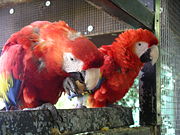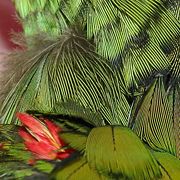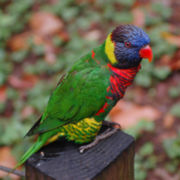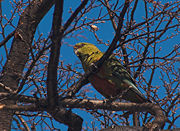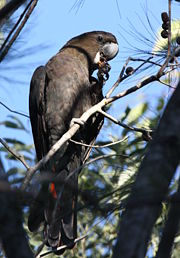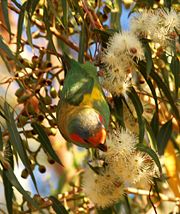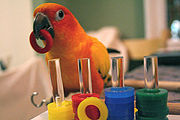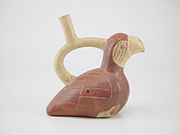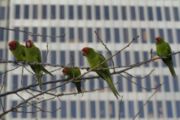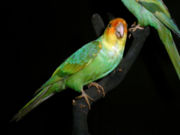Parrot
2008/9 Schools Wikipedia Selection. Related subjects: Birds
| Parrots Fossil range: Early Eocene – Recent |
||||||||
|---|---|---|---|---|---|---|---|---|
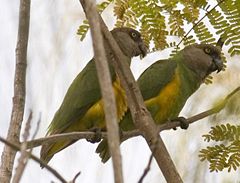 A pair of Senegal Parrots in Africa
Poicephalus senegalus |
||||||||
| Scientific classification | ||||||||
|
||||||||
| Systematics | ||||||||
|
(but see below) Family Cacatuidae (cockatoos)
Family Psittacidae (true parrots)
( paraphyletic) |
Parrots are birds of the roughly 350 species in 85 genera comprising the order Psittaciformes, found in most warm and tropical regions. Also known as psittacines (pronounced /ˈsɪtəsaɪnz/), they are usually grouped into two families: the Psittacidae (true parrots) and the Cacatuidae (cockatoos). Characteristic features of parrots include a strong curved bill, an upright stance, strong legs, and clawed zygodactyl feet. Most parrots are predominantly green, with other bright colors, and some species are multi-colored. Cockatoo species range from mostly white to mostly black, and have a mobile crest of feathers on the top of their heads. Most parrots are monomorphic or minimally sexually dimorphic.
Parrots, along with crows, jays and magpies, are some of the most intelligent birds, and their ability to imitate human voices enhances their popularity as pets. Trapping of wild parrots for the pet trade, as well as other hunting, habitat loss and competition from invasive species, have diminished wild populations, and more parrots are threatened with extinction than any other group of birds.
The most important components of most parrots' diets are seeds, nuts, fruit, buds and other plant material, and a few species also eat insects and small animals, and the lories and lorikeets are specialised to feed on nectar from flowers, and soft fruits. Almost all parrots nest in tree holes (or nestboxes in captivity), and lay white eggs from which emerge altricial (helpless) young.
Extant species range in size from the Buff-faced Pygmy-parrot, under 10 g (0.35 oz.) and 8 cm (3.2 inches), to the Hyacinth Macaw, at 1 meter (3.3 feet) in length, and the Kakapo, at 4 kg (8.8 lbs). They are the most variably sized bird order in terms of length. Some atypical parrots include the dimorphic Eclectus (the male is green and the female is red), the flightless lek breeding Kakapo. The Kaka, Kea and the Long-billed Corella have especially curved upper mandibles.
Evolution and systematics
Origins and evolution
The diversity of Psittaciformes in South America and Australasia suggests that the order has a Gondwanan origin. The parrot family's fossil record, however, is sparse and their origin remains a matter of informed speculation rather than fact.
A single 15 mm fragment from a lower bill ( UCMP 143274), found in Lance Creek Formation deposits of Niobrara County, Wyoming, has been suggested as the first parrot fossil. Of Late Cretaceous age, it is about 70 million years old. But subsequent reviews have established that this fossil is almost certainly not from a bird, but from a caenagnathid theropod — a non-avian dinosaur with a birdlike beak.
It is now generally assumed that the Psittaciformes or their common ancestors with a number of related bird orders were present somewhere in the world around the Cretaceous–Tertiary extinction event, some 65 mya (million years ago). If so, they probably had not evolved their morphological autapomorphies yet, but were generalized arboreal birds, roughly similar (though not necessarily closely related) to today's potoos or frogmouths (see also Palaeopsittacus below).
Europe is the origin of the first generally accepted parrot fossils. The first is a wingbone of Mopsitta tanta, uncovered in Denmark and dated to 55 mya (million years ago). The climate at this time was tropical, consistent with the Paleocene-Eocene Thermal Maximum.
Later fossils date from the Eocene, starting around 50 mya. Several fairly complete skeletons of parrot-like birds have been found in England and Germany. Some uncertainty remains, but on the whole it seems more likely that these are not direct ancestors of the modern parrots, but related lineages which evolved in the Northern Hemisphere but have since died out. These are probably not " missing links" between ancestral and modern parrots, but rather psittaciform lineages that evolved parallel to true parrots and cockatoos and had their own peculiar autapomorphies:
- Psittacopes (Early/Middle Eocene of Geiseltal, Germany) — basal?
- Serudaptus - pseudasturid or psittacid?
- Pseudasturidae ( Halcyornithidae may be correct name)
- Pseudasturides - formerly Pseudastur
- Quercypsittidae
- Quercypsitta (Late Eocene)
The earliest records of modern parrots date to about 23–20 mya and are also from Europe. Subsequently, the fossil record — again, mainly from Europe — consists of bones clearly recognizable as belonging to parrots of modern type. The Southern Hemisphere does not have nearly as rich a fossil record for the period of interest as the Northern, and contains no known parrot-like remains earlier than the early to middle Miocene, around 20 mya. At this point, however, is found the first unambiguous parrot fossil (as opposed to a parrot-like one), an upper jaw which is indistinguishable from that of modern cockatoos. A few modern genera are tentatively dated to a Miocene origin, but their unequivocal record stretches back only some 5 million years (see genus articles for more).
The named fossil genera of parrots are probably all in the Psittacidae or close to its ancestry:
- Archaeopsittacus (Late Oligocene/Early Miocene)
- Xenopsitta (Early Miocene of Czechia)
- Psittacidae gen. et spp. indet. (Bathans Early/Middle Miocene of Otago, New Zealand) - several species
- Bavaripsitta (Middle Miocene of Steinberg, Germany)
- Psittacidae gen. et sp. indet. (Middle Miocene of France) - erroneously placed in Pararallus dispar, includes "Psittacus" lartetianus
Some Paleogene fossils are not unequivocally accepted to be of psittaciforms:
- Palaeopsittacus (Early - Middle Eocene of NW Europe) - caprimulgiform (podargid?) or quercypsittid?
- " Precursor" (Early Eocene) - part of this apparent chimera seems to be of a pseudasturid or psittacid
- Pulchrapollia (Early Eocene) — includes "Primobucco" olsoni - psittaciform (pseudasturid or psittacid)?
Phylogeny
The phylogeny of the parrots is still under investigation. The classifications as presented reflects the current status, which is disputed and therefore subject to change when new studies resolve some of the open questions. For that reason, this classification should be treated as preliminary.
The Psittaciformes are generally considered to consist of two major living lineages of family rank: the true parrots (Psittacidae) and the cockatoos (Cacatuidae).
The Cacatuidae are quite distinct, having a movable head crest, a different arrangement of the carotid arteries, a gall bladder, differences in the skull bones, and lack the Dyck texture feathers which, in the Psittacidae, scatters light in such a way as to produce the vibrant colours of so many parrots. However, the actual situation may be more complex (see below).
While understanding of the relationships between subgroups of true parrots — for example, the one containing the Grey Parrot versus the relatives of the Budgerigar — are rather well resolved and knowledge of relationships between species has much improved in the last years, it is still a matter of dispute whether the distinct lineages of true parrots should be considered subfamilies or tribes. Because parrot fossils and molecular divergence date estimates provide insufficient data to properly resolve when exactly the major diversification and divergence periods in parrot evolution took place, it is difficult to determine how distinct from one another the various lineages really are, and how fast and radically they were changed by evolution.
Lorikeets were previously regarded as a third family, Loriidae, though now most often considered a subfamily of the Psittacidae. The present majority view is that they are distinct enough to warrant subfamily status, but some consider the quite pronounced differences not evidence of a uniquely deep evolutionary split but rather not different quantitatively from the differences between more closely related lineages. Biogeography suggests that the lorikeets are best considered a uniquely distinct lineage, not as divergent as cockatoos maybe, but still standing apart from other psittacids.
Recent molecular studies, such as that of mtDNA in 1998, or the sex chromosome spindlin gene in 2005, find the relationships of the main lineages of living parrots to be for the most part unresolvable with any confidence. An unexpected result was that according to the spindlin sequence data, the only major divergence among living parrots that could be reliably positioned in the calculated phylogenies occurred between some New Zealand parrots - Kakapo, Kākā and Kea - and the remaining psittaciformes.
The case for distinctness of at least the nestorines seems to be fairly complete by now. Its position - with or without the Kakapo - and its ancient age as suggested by the molecular data are at odds with the fossil record though, as it would require an absurdly high degree of homoplasy and a decidedly non- parsimonious character distribution in living parrots. As the study relies upon an obsolete molecular clock model uncalibrated by material evidence, the results are highly spurious. The scenario of Miyaki et al. (1998), while less complete (and excluding the kakapo) agrees better, though not completely, with the material evidence. Again, an unreliable molecular clock model was used.
While the latter two seem indeed to constitute a distinct lineage, placement of the Kakapo with these is contradicted by mtDNA cytochrome b sequence data. In any case, the major lineages of psittacines seem indeed to represent distinct clades, but their relationship among them is not well resolvable by the present molecular data. They appear to have radiated throughout a fairly limited timespan, approximately during the Eocene. One finding of major importance is that neither cockatoos nor lories seem to be as distinct from other major parrot lineages as they are usually assumed to be.
Systematics
The following classification is a version in which several subfamilies are recognized. Molecular data (see above) suggests that several subfamilies might indeed be valid and perhaps even be elevated to family rank, but the arrangement of tribes in these is not well resolved at present.
Family Psittacidae: true parrots
- Subfamily Arinae: Neotropical parrots, about 160 species in some 30 genera. Probably 2 distinct lineages:
- Subfamily Loriinae: Around a dozen genera with some 50 species of lorikeets and lories, centered in New Guinea, spreading to Australia, Indonesia, and the islands of the south Pacific.
- Subfamily Micropsittinae: 6 species of pygmy parrot, all in a single genus.
- Subfamily Nestorinae or Strigopinae: The New Zealand parrots.
- Tribe Nestorini: 1 genus with only 2 living species, the Kea and Kākā of the New Zealand region.
- Tribe Strigopini: The flightless, nearly extinct Kakapo of New Zealand.
- Subfamily Psittacinae
- Tribe Cyclopsitticini: fig parrots, 3 genera, all from New Guinea or nearby.
- Tribe Polytelini: three genera from Australia and the Wallacea. - may belong to broad-tailed parrots.
- Tribe Psittrichadini: A single species, Pesquet's Parrot.
- Tribe Psittacini: Afrotropical parrots, about a dozen species in 3 genera.
- Tribe Psittaculini: Paleotropic psittaculine parrots, nearly 70 living species in 12 genera, distributed from India to Australasia.
- Subfamily Platycercinae: Broad-tailed parrots; nearly 30 species in roughly one dozen genera.
- Tribe Melopsittacini: one genus with one species, the Budgerigar.
- Tribe Neophemini: two small genera of parrots.
- Tribe Pezoporini: one genus of parrots with two quite distinct species.
- Tribe Platycercini: Rosellas and relatives; around 20 species in 8 genera.
Other lists
- A list of all parrots sortable by common or binomial name, about 350 species.
- Taxonomic list of Cacatuidae species, about 20 species in 6 genera
- Taxonomic list of true parrots which provides the sequence of Psittacidae genera and species following a traditional two-subfamily approach, as in the taxobox above, about 330 species.
Range and distribution
Parrots are found on all tropical and subtropical continents including Australia and the islands of the Pacific Ocean, India, southeast Asia, southern regions of North America, South America and Africa. Some Caribbean and Pacific islands are home to endemic species. By far the greatest number of parrot species come from Australasia and South America.
Several parrot species enter the cool, temperate regions of South America and New Zealand. One species, the Carolina Parakeet existed in temperate North America, but was hunted to extinction in the early 20th century. Numerous species have been introduced in areas with temperate climates, and have established stable populations. The Monk Parakeet currently breeds in at least 15 U.S. states.
While a few parrot species are wholly sedentary or fully migratory, the majority fall somewhere between the two, making poorly understood regional movements, some species adopting an entirely nomadic lifestyle.
Morphology
Parrots are sometimes referred to as "hookbills," which alludes to their most notable physical characteristic: their strong, curved, broad bill. The upper mandible is prominent, curves downward, and comes to a point. It is not fused to the skull, which allows it to move independently, and contributes to the tremendous biting pressure these birds are able to exert. The lower mandible is shorter, with a sharp, upward facing cutting edge, which moves against the flat portion of the upper mandible in an anvil-like fashion. Seed eating parrots have a strong tongue which helps to manipulate seeds or position nuts in the bill so that the mandibles can apply an appropriate cracking force. The head is large, with eyes positioned sideways, which limits binocular vision, but greatly enhances peripheral vision. They have an upright stance, strong legs, and clawed feet, with two toes facing forward and two toes facing rearward on each foot, ( zygodactyl).
Cockatoo species have a mobile crest of feathers on the top of their heads which can be raised for display, and retracted.
Behaviour
Parrots have a strong, direct flight. Most species spend most of their time perched or climbing in tree canopies. They often use their bills for climbing by gripping or hooking on branches and other supports. On the ground parrots often walk with a rolling gait.
Diet
The diet of parrots consists of seeds, fruit, nectar and pollen and to a lesser degree animal prey. Without question the most important of these to most true parrots and cockatoos are seeds. The evolution of the large and powerful bill can be explained primarily as an adaptation to opening and consuming seeds. All true parrots except the Pesquet's Parrot employ the same method to obtain the seed from the husk; the seed is held between the mandibles and the lower mandible crushes the husk, whereupon the seed is rotated in the bill and the remaining husk is removed. A foot is sometimes used in order to help holding large seeds in place. Parrots are seed predators rather than seed dispersers; and in many cases where species are recorded as consuming fruit they are only eating the fruit in order to get at the seed. As seeds often have poisons to protect them, parrots are careful to remove seed coats and other fruit parts which are chemically well defended, prior to ingestion. Many species in the New World, Africa, and Papua New Guinea consume clay which both releases minerals and absorbs toxic compounds from the parrots' gut.
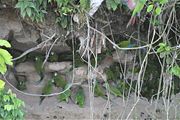
The Lories and lorikeets, Swift Parrot and Philippine Hanging Parrot are primarily nectar and pollen consumers, and have tongues with brush tips to collect this source of food, as well as some specialized gut adaptations to accommodate this diet. Many other species also consume nectar as well when it becomes available.
In addition to feeding on seeds and flowers, some parrot species will prey on animals. Golden-winged Parakeets prey on water snails, and famously the Keas of New Zealand will scavenge on sheep carcases and even kill juvenile petrels. Another New Zealand parrot, the Antipodes Island Parakeet, enters the burrows of nesting Grey-backed Storm-petrels and kills the incubating adults. Some cockatoos and the Kākā will also excavate branches and wood in order to obtain grubs.
Breeding
Although there are a few exceptions, parrots are monogamous breeders which nest in cavities and hold no territories other than their nesting sites. Only the Monk Parakeet and five species of Agapornis lovebird build nests in trees, and three Australian and New Zealand ground parrots nest on the ground. All other parrots and cockatoos nest in cavities, either tree hollows or cavities dug into cliffs, banks, termite nests or the ground.
The eggs of parrots are white. In most species the female undertakes all the incubation, although incubation is shared for a few species. The female remains in the nest for almost all of the incubation period and is fed by the male.
As typical of K-selected species, the macaws and other larger parrot species have low reproductive rates. They require several years to reach maturity, produce one or very few young per year, and sometimes do not breed every year at all.
Intelligence
Studies with captive birds have given us insight into which birds are the most intelligent. While parrots have the distinction of being able to mimic human speech, studies with the African Grey Parrot have shown that some are able to associate words with their meanings and form simple sentences (see Alex and N'kisi). Along with crows, ravens, and jays (family Corvidae), parrots are considered the most intelligent of birds. The brain-to body size ratio of psittacines and corvines is actually comparable to that of higher primates. One argument against the supposed intelligent capabilities of bird species is that birds have a relatively small cerebral cortex, which is the part of the brain considered to be the main area of intelligence in other animals. However, it seems that birds use a different part of their brain, the medio-rostral neostriatum/ hyperstriatum ventrale, as the seat of their intelligence. Not surprisingly, research has shown that these species tend to have the largest hyperstriata, and Dr. Harvey J. Karten, a neuroscientist at UCSD who has studied the physiology of birds, discovered that the lower part of avian brains are functionally similar to ours. Not only have parrots demonstrated intelligence through scientific testing of their language using ability, but some species of parrot such as the Kea are also highly skilled at using tools and solving puzzles.
Sound imitation and speech
Many species can imitate human speech or other sounds, and the results of a study by Irene Pepperberg suggested a high learning ability in an African Grey Parrot named Alex. Alex was trained to use words to identify objects, describe them, count them, and even answer complex questions such as "How many red squares?" with over 80% accuracy. A second example is that of N'kisi, another African grey, which has been shown to have a vocabulary of approximately a thousand words and has displayed an ability to invent as well as use words in context and in the correct tense.
Parrots do not have vocal cords, so sound is accomplished by expelling air across the mouth of the bifurcated trachea. Different sounds are produced by changing the depth and shape of trachea. So, talking parrots are really whistling in different variations. Congo African Grey Parrots (CAG) are well known for their ability to "talk", which may be caused by more control, or stronger trachea. But that does not mean that a Cockatiel (Cockatiels are not well known for their talking ability), could have a greater vocabulary than an African Grey Parrot.
This ability has made them prized as pets from ancient time to now. In the Masnavi, a writing by Rumi of Persia, AD 1250, the author talks about an ancient method for training parrots to speak.
"Parrots are taught to speak without understanding the words. The method is to place a mirror between the parrot and the trainer. The trainer, hidden by the mirror, utters the words, and the parrot, seeing his own reflection in the mirror, fancies another parrot is speaking, and imitates all that is said by the trainer behind the mirror."
Relationship with humans
Humans and parrots have a complicated relationship. Economically they can be beneficial to communities as sources of income from the pet trade and are highly marketable tourism draws and symbols. But some species are also economically important pests, particularly some cockatoo species in Australia. Some parrots have also benefited from human changes to the environment in some instances, and have expanded their ranges where agricultural practices, and many parrots have declined as well.
As tens of millions of individuals have been removed from the wild, parrots have been traded in greater numbers and for far longer than any other group of wild animals . A large number of parrot species are threatened by this trade as well as habitat loss, predation by introduced species and other forms of hunting. Some parrot species are agricultural pests, eating fruits, grains, and other crops, but parrots can also benefit economies through birdwatching based ecotourism.
Parrots as pets
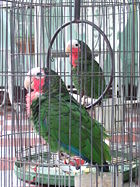
Popular as pets due to their sociable and affectionate nature, high intelligence, bright colours and ability to imitate human voices, parrots have historically been kept captive in many cultures. Europeans kept birds matching the description of the Rose-ringed Parakeet (or called the ring-necked parrot), such as in this first century account by Pliny the Elder. As they have been prized for thousands of years for their beauty and ability to talk, they have also proven hard to care for. For example, author Wolfgang de Grahl discusses in his 1987 book "The Grey Parrot," that some importers allowed parrots to drink only coffee while they were being shipped by boat considering pure water to be detrimental and believing that their actions would increase survival rates during shipping. (These days it is commonly accepted that the caffeine in coffee is toxic to birds.)
Pet parrots may be kept in a cage or aviary; though generally, tame parrots should be allowed out regularly on a stand or gym. Depending on locality, parrots may be either wild caught or be captive bred, though in most areas without native parrots, pet parrots are captive bred.
Parrots species that are commonly kept as pets include conures, macaws, Amazons, cockatoos, African Greys, lovebirds, cockatiels, budgerigars, eclectus, Caiques, parakeets, Pionus and Poicephalus. Species vary in their temperament, noise level, talking ability, cuddliness with people, and care needs, although how a parrot has been raised usually greatly affects its personality.
Parrots are popular as pets due to their beauty, intelligence, and sociable natures. In 1992 the newspaper USA Today published that there were 11 million pet birds in the United States alone, many of them parrots. The domesticated budgie or common parakeet, a small parrot, is the most popular of all pet bird species.
Parrots can make excellent companion animals, and can form close, affectionate bonds with their owners. However, they are not low maintenance pets; they require feeding, grooming, veterinary care, training, environmental enrichment through the provision of toys, exercise, and social interaction (with other parrots or humans) for good health. Some large parrot species, including large cockatoos, Amazon, and macaws, have very long lifespans with 80 years being reported and record ages of over one hundred. Small parrots, such as lovebirds, hanging parrots, and budgies have short life spans of up to 15-20 years. Some parrot species can be quite loud, and most larger parrots can be destructive and require a regular supply of new toys, branches, or other items to chew up.
The popularity, longevity, and intelligence of many of the larger pet parrots has led to many of these birds being rehomed during the course of their long lifespans. A common problem is that large parrot species purchased as cuddly, gentle babies will mature into complex, often demanding, adults that can outlive their owners. Due to these problems, and the fact that homeless parrots are not euthanized like dogs and cats, parrot adoption centers and sanctuaries are becoming more common.
Trade of parrots
The popularity of parrots as pets has led to a thriving - and often illegal - trade in the birds, and some species are now threatened with extinction. A combination of trapping of wild birds and damage to parrot habitats makes survival difficult or even impossible for some species of parrot.
The trade continues unabated in some countries. A report published in January 2007 presents a clear picture of the wild-caught parrot trade in Mexico, stating: "The majority of parrots captured in Mexico stay in the country for the domestic trade. A small percentage of this capture, 4% to 14%, is smuggled into the USA."
The scale of the problem can be seen in the Tony Silva case of 1996, in which a parrot expert and former director at Tenerife's Loro Parque (Europe's largest parrot park) was jailed in the United States for 82 months and fined $100,000 for smuggling Hyacinth Macaws. (Such birds command a very high price.) The case led to calls for greater protection and control over trade in the birds. Different nations have different methods of handling internal and international trade. Australia has banned the export of its native birds since 1960. The United States protects its only native parrot through its Endangered Species Act, and protects other nations' birds through its Wild Bird Conservation Act. Following years of campaigning by hundreds of NGOs and outbreaks of avian flu, in July 2007, the European Union halted the importation of all wild birds with a permanent ban on their import. Prior to an earlier temporary ban started in late October 2005, the EU was importing approximately two million live birds a year, about 90% of the international market: hundreds of thousands of these were parrots. There are no national laws protecting feral parrot populations in the USA. Mexico has a licensing system for capturing and selling native birds (though the laws are not well enforced).
Parrots and culture
Parrots have featured in human writings, story, art, humor, religion and music for thousands of years. From the Roman poet Ovid's "The Dead Parrot" (Latin), (English) to Monty Python's Dead Parrot Sketch millennia later, parrot have existed in the consciousness of many cultures. Recent books about parrots in human culture include Parrot Culture.
In ancient times and currently parrot feathers have been used in ceremonies, and for decoration. The "idea" of the parrot has been used to represent the human condition in medieval literature such as the bestiary. They also have a long history as pets.
Currently parrots feature in many media. There are magazines devoted to parrots as pets, and to the conservation of parrots ( PsittaScene). Recent fictional books featuring parrots include Next. Fictional films include Paulie, and documentaries include The Wild Parrots of Telegraph Hill.
Parrots have also been considered sacred. The Moche people of ancient Peru worshipped birds and often depicted parrots in their art.
Parrots are used as symbols of nations and nationalism. A parrot is found on the flag of Dominica. The St. Vincent parrot is the national bird of St. Vincent and the Grenadines, a Caribbean nation.
Sayings about parrots colour the modern English language. The verb "parroting" can be found in the dictionary, and means "to repeat by rote." There are also clichés, such as the British saying "sick as a parrot." Fan of musical artist Jimmy Buffett call themselves "parrot heads."
It is possible to devote entire careers to parrots. Zoos and aquariums employ keepers to care for and shape the behaviour of parrots. Some veterinarians who specialize in avian medicine will treat exclusively for parrots. Biologists study parrot populations in the wild and help to conserve wild populations. Aviculturalists will breed and sell parrots for the pet trade.
Feral populations
Escaped parrots of several species have become established in the wild outside their natural ranges and in some cases outside the natural range of parrots. Among the earliest instances were pet Red Shining-parrots from Fiji which established a population on the islands of southern Tonga. These introductions were prehistoric and Red-shining Parrots were recorded in Tonga by Captain Cook in the 1770s. Escapees first began breeding in cities in California, Texas and Florida in the 1950s (with unproven earlier claims dating back to the 1920s in Texas and Florida). They have proved surprisingly hardy in adapting to conditions in Europe and North America. They sometimes even multiply to the point of becoming a nuisance or pest, and a threat to local ecosystems.
Threats and conservation
A large number of parrot species are in decline, and several species are now extinct. Of the 350 or so living species of parrot 130 species are listed as near threatened or worse by the IUCN. There are numerous reasons for the decline of so many species, the principal threats being habitat loss, hunting, and for some species, wild-bird trade. Parrots are persecuted for a number of reasons; in some areas they may (or have been) hunted for food, for feathers, and as agricultural pests. For a time, Argentina offered a bounty on quaker parakeets (an agricultural pest), resulting in hundred of thousands of birds being killed, though apparently this did not greatly affect the overall population . Capture for the pet trade is a threat to many of the rarer or slower to breed species. Habitat loss or degradation, most often for agriculture, is a threat to numerous parrot species. Parrots, being cavity nesters, are vulnerable to the loss of nesting sites and to competition with introduced species for those sites. The loss of old trees is particularly a problem in some areas, particularly in Australia where suitable nesting trees may be many hundreds of years old. Many parrot species occur only on islands and are |vulnerable to introduced species such as rats and cats, as they lack the appropriate anti-predator behaviours needed to deal with mammalian predators. Controlling such predators can help in maintaining or increasing the numbers of endangered species. Insular species, which have small populations in restricted habitat, are also vulnerable to physical threats such as hurricanes and volcanic eruptions.
Trade, export and import of all wild-caught parrots is regulated and only permitted under special licensed circumstances in countries party to CITES, the Convention on the International Trade in Endangered Species, that came into force in 1975 to regulate the international trade of all endangered wild caught animal and plant species. In 1975, 24 parrot species were included on Appendix I of CITES, thus prohibiting commercial international trade in these birds. Since that initial listing, continued threats from international trade have lead CITES to add an additional 32 parrot varieties to Appendix I, including nine in the last four years. All the other parrot species are protected on Appendix II of CITES. In addition, individual countries may have laws to regulate trade in certain species.
There are many active conservation groups whose goal is the conservation of wild parrot populations. These groups tend to be supported the most by pet owners who care deeply about parrots. One of the largest includes The World Parrot Trust, an international organization. The group gives assistance to worthwhile projects as well as producing a magazine and raising funds through donations and memberships. They state they have helped conservation work in 22 countries. On a smaller scale local parrot clubs (or hookbill clubs as they're called,) will raise money to donate to a cause of conservation. Zoo and wildlife centers usually provide public education, to change habits that cause damage to wild populations. A popular attraction that many zoos now employ is a feeding station for lories and lorikeets, where visitors feed small parrots with cups of liquid food. This is usually done in association with educational signs and lecture.
